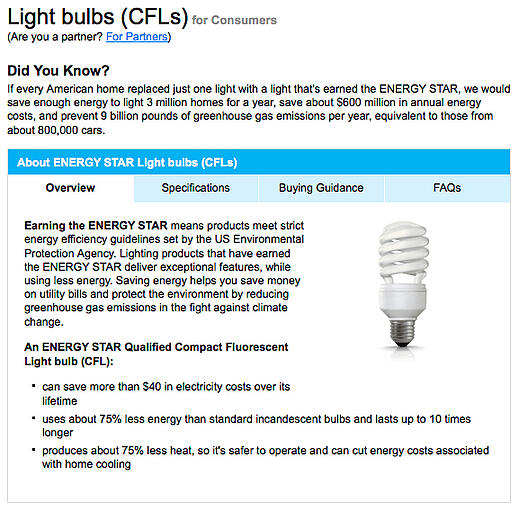Much concern has risen regarding the topic of energy usage and sustainability in the past decade. Temperatures and calamities are on the rise and solutions seem to be popping up left and right. Out of this turmoil a somewhat elusive super-hero was born. With an environmental consciousness, the Compact Florescent Bulb came to the rescue. It uses 75% less energy and can last almost 10 times as long as a regular florescent or incandescent bulb. Better yet, it's Energy Star certified, by the US Department of Energy AND the Environmental Protection Agency. Here is a what the site says:

In New Zealand, following a ban placed on the purchasing of new traditional fluorescent and incandescent light bulbs, the Minister of Energy and Resources, Gerry Brownlee, contested it to the point of repeal. Listed in his arguments against the ban was evidence that beside the supposed benefits, CFL bulbs contain a significant amount of mercury and are not able to be recycled. Beyond this were concerns for countries like China and India who are producing CFL bulbs at a rapid pace for the entire world. The mercury that is used in the factories overseas is currently seeping into the water tables and contaminating the lands for current citizens and future generations. Brownlee says, "People need good, credible information about the different lighting options that are available to them, and then they can decide what is right for them in their homes."
This is thin ice for us here at Niche Modern. We are committed to the environment at our headquarters and conscious of decisions in our own lives and our families, but obviously, this news was a breath of fresh air for us. We've come to know and love the Edison filament bulb, with it's remarkably simple and sleek design. We'd be torn to know that these exposed bulbs would have to disappear entirely due to government standards and heightened fears about correct sustainability practices, without knowing the possible consequences of these stringent mandates. We are committed to experimenting with and researching more efficient bulbs in the future. "Lifting the previous government's ban on incandescent light bulbs simply means we are allowing their continued sale, and I am confident the consumer trend to energy efficient bulbs will continue," said Mr Brownlee.
For more information regarding the public perspective and experience in the use of CFL bulbs, here are some links:
"... We replaced a lot of incandescents because we wanted to reduce our energy bill. We started experiencing nausea (flu season, right?), extreme migraine headaches (allergies, right?) that refused to go away, unexplained skin rashes and arthritic-like joint pain, even in our daughters. This went on for 3 solid months..."
Source:http://peswiki.com/index.php/Talk:Directory:Compact_Fluorescent_Bulb_%28CFL%29_Dangers
"An International Association for Energy-Efficient Lighting (IAEEL) study conducted in Denmark, explored some carbon footprint factors, but not all, showing it took 1.8 Kwh of electricity to assemble a CFL compared to 0.11 Kwh to assemble an incandescent bulb. That means it took 16 times more energy to produce a CFL."
Source:http://www.greenmuze.com/blogs/guest-bloggers/1031-the-dark-side-of-cfls.html